Despite their “micro” size, microgreens are considered a superfood high in nutritional value amongst many things. The ease of growing and maintaining them makes them a popular food choice for those eager to up their nutritional intake while having to do little to no gardening work. In this article we’ll take a look at the 14 most nutritious microgreens.
Microgreens are also versatile in their uses and can be eaten with or on just about anything, making them the perfect addition to any salad, soup, or sandwich.
What are the most nutritious microgreens to grow and eat? There are over 100 types of microgreens and wait for it . . . they are all highly nutritious! The reason there are so many is that microgreens can be grown from any type of herb or vegetable seed. They are all nutritious, however, some are more than others.
The 14 most nutritious microgreens to grow and eat are:
As far as nutritional value goes, some microgreens have higher levels of a certain vitamin or mineral than other microgreens.
For instance, microgreens such as cilantro, green daikon radish, and red cabbage have the highest amounts of vitamins C, K, and E compared to 21 other varieties of microgreens tested and studied by the US Department of Agriculture (USDA).
Continue to read to find out more about the most nutritious microgreens and why these 14 microgreens stand out when it comes to their nutritional value.
What Are Microgreens And How Are They Grown?
Microgreens are not to be confused with sprouts, as they have a longer germination period and do not require full immersion in water to grow, unlike sprouts. Think of them as basically vegetable greens, they are much smaller compared to fully matured greens yet maintain a small size packed with nutrients.
Microgreens are very popular amongst fine dining restaurants and the health food trend. The fact that they can easily be used to garnish dishes or as an additive to smoothies, juices, and other blends makes them an easy go-to for many people.
Microgreens can be easily grown in a home environment, which is another reason why they are so popular.
RELATED: Can You Eat Too Many Microgreens?
Universal Methods For Growing Microgreens
All microgreens are grown using the same general methods such as soil or by the use of a hydroponic system.
“Hydroponic, by definition, is a method of growing plants in a water-based, nutrient-rich solution. Hydroponics does not use soil, instead, the root system is supported using an inert medium such as perlite, rock wool, clay pellets, peat moss, vermiculite.
The basic premise behind hydroponics is to allow the plant’s roots to come in direct contact with the nutrient solution, while also having access to oxygen, which is essential for proper growth.”
If you do use soil, it’s important to calculate the seeding rate to get the best results. The seeding rate is the number of germinating seeds plus their weight. This isn’t exactly of high importance if you are a beginner microgreen grower, but it is something to take note of as you gain more experience.
Microgreens can be grown in any type of container, however, the best is one that provides air and moisture without too much or too little of either. Although there exists a universal growing guideline for growing microgreens, each one may require a specific method over another.
The germination and harvest rate also differs from one microgreen to another. Before setting up your planting and growing environment, make sure you take into consideration the best methods for producing the best microgreens of quality.
READ ALSO: The Best Microgreen Growing Kits You can Buy Today
The Most Nutritious Microgreens
Now when you know more about what microgreens are, let us introduce you to some of the most nutritious ones you can easily grow.
Sunflower
If you love sunflowers in general for their bright yellow petals and iconic look, you’ll be even happier to know that they offer edible components such as the microgreen. Sunflower microgreens are highly nutritious and can help to lower blood cholesterol, regulate hormones, and provide essential amino acids.
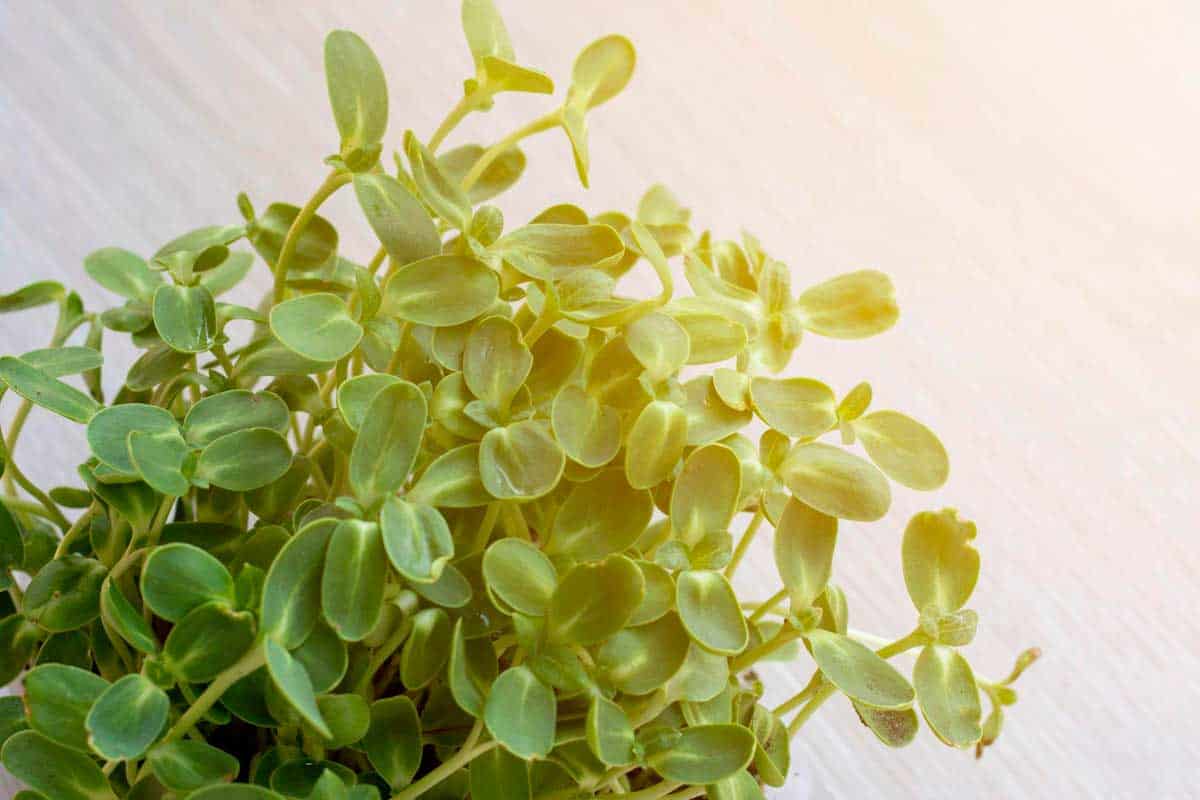
Sunflower microgreens are low in calories and they have a high content of Vitamins A, B, D and E. They also contain Beta-Caretone, Lutein, Calcium, Iron, Magnesium, Potassium, and Phosphorus.
It is one of the best foods to add to your diet for overall health and wellbeing.
To start the growth process, sunflower seeds should be soaked for at least 8 to 24 hours, 12 hours is a safe range if you’re unsure of exactly how long your seeds should soak. Soaking is very important, as it maximizes the potential germination rate and the growing success of your microgreens overall.
The germination window is about 1 to 2 days and the microgreens should be ready to harvest in about 7 to 10 days total. The average seeding rate for sunflower microgreens are about 125 grams, this is based on a 10” by 20” tray. This number may vary is you are using a bigger or smaller growing medium or tray.
Learn more about Sunflower Microgreens.
Radish
Radish is one of the more popular microgreens because it is relatively easy to grow. Some other common names for radish microgreens are daikon and oriental. Much like full-grown radish, radish microgreens have a mild spicy or peppery flavor.
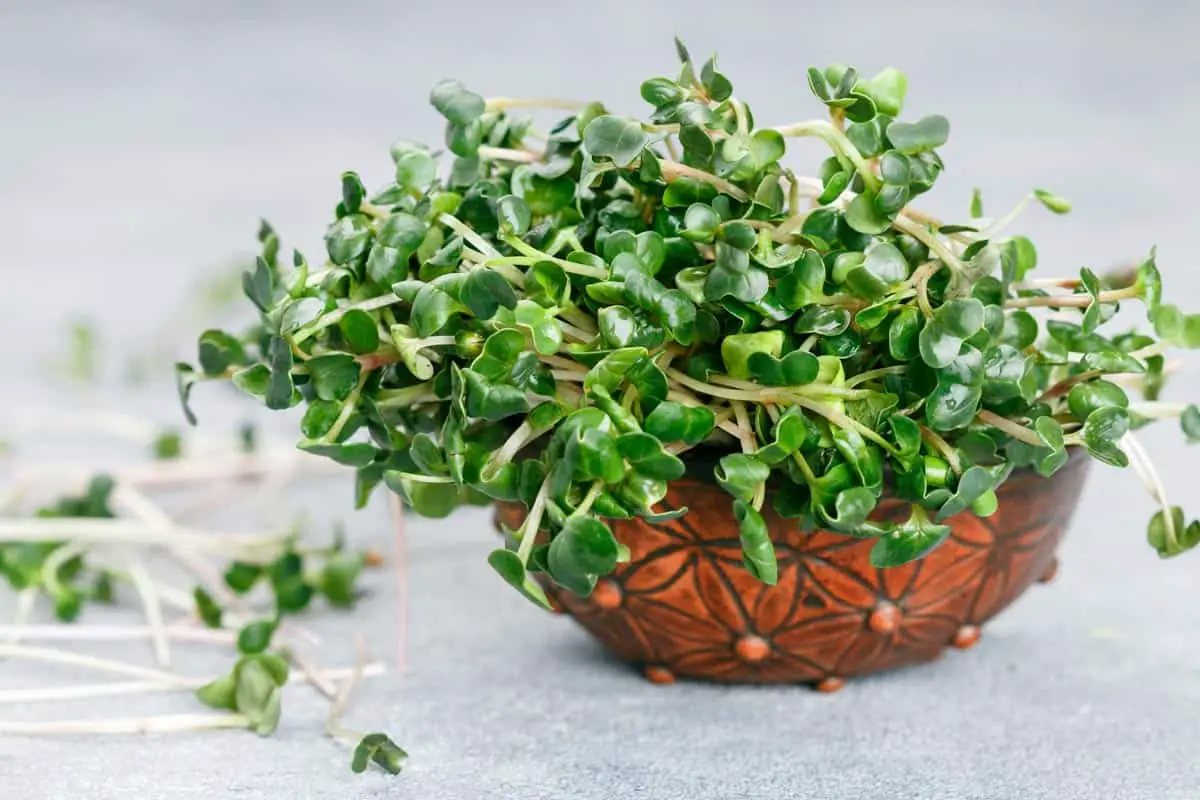
These microgreens are high in vitamins A, B, C, E, and K as well as carotene. They also contain potassium, are high in dietary fiber, and help in relieving occasional constipation amongst many other health benefits.
Other nutrient contents are folic acid, niacin, iron, phosphorus, pantothenic acid, calcium, magnesium, and zinc.
Radish seeds don’t require soaking before planting. Germination for radish seeds is typically about 4 days and microgreens are ready for harvesting between 8 to 12 days.
Learn more about Radish Microgreens.
Arugula
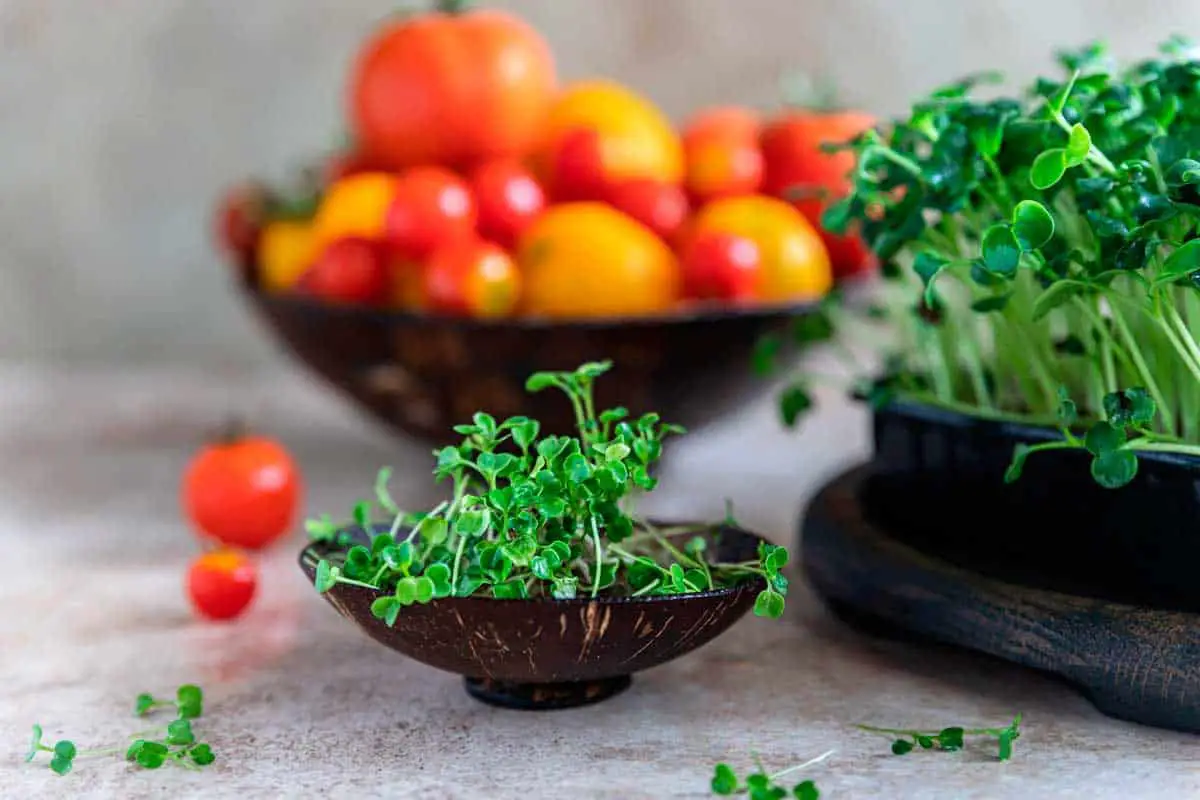
Arugula microgreens (also known as rocket or rucula) are packed full of vitamin C and much like mature arugula, they share the same bitter peppery taste. These microgreens are great for taking any salad or leafy dish from mediocre to exceptional in both taste and appearance!
Besides being known for their unique taste, arugula microgreens also provide several nutritional and health benefits:
- Provide antioxidants
- A good source of copper and vitamins A, C, and K
- Helps to lower blood pressure
- Promotes healthy bone development
- Detoxifies food
Arugula microgreens also do not require soaking and usually germinate within 5 days. The average harvesting window is between 10 to 14 days. They germinate quickly and they are ideal as they grow well in both cold and hot temperatures.
An important tip to remember is not to overwater the seeds, as arugula seeds do not require lots of moisture. They tend to grow better and prefer relatively low moisture environments.
Learn more about Arugula Microgreens.
Broccoli
If you or your child is one to fear the leafy green goodness of broccoli, fear no more! Broccoli microgreens are a lot less scary than their mature counterpart and provide the same nutritional value if not more. Broccoli microgreens have a milder taste compared to larger broccoli and are slightly bitter.
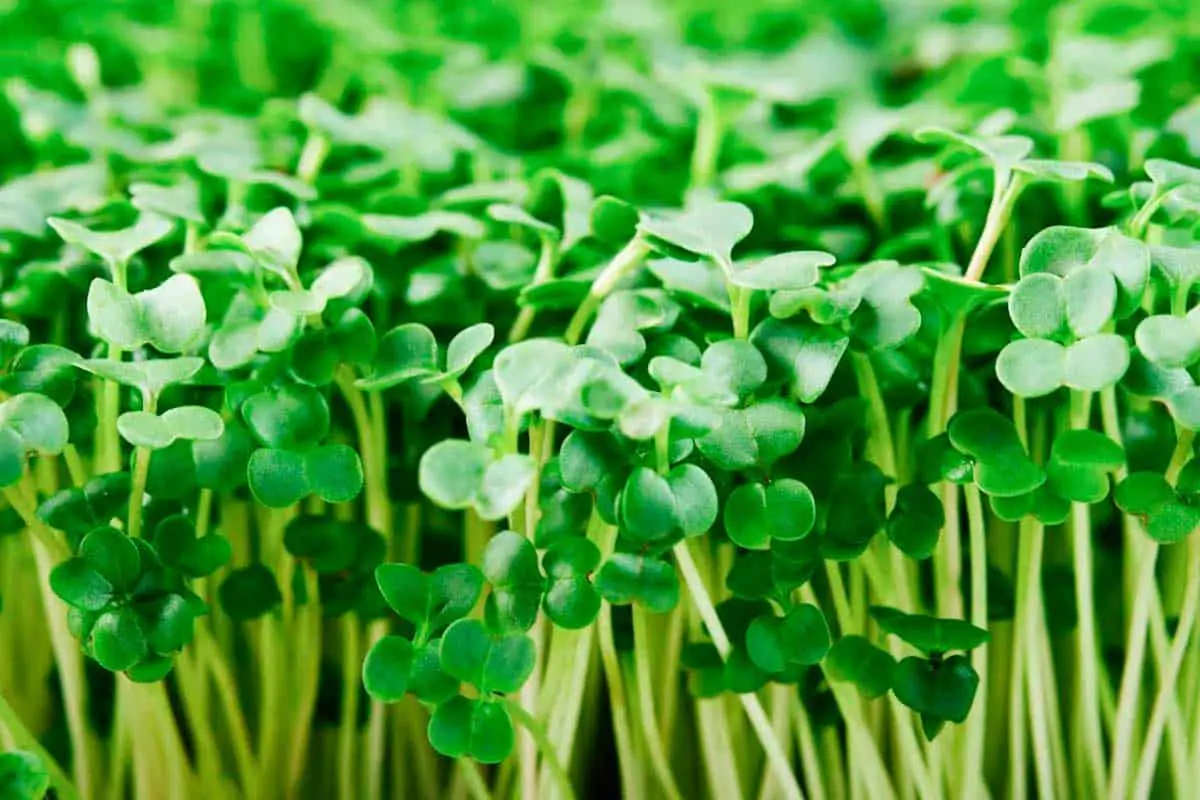
Broccoli as a whole is a great addition to a healthy diet and its microgreens are even better due to the rich presence of a compound called sulforaphane, the reason behind its slightly bitter taste. Sulforaphane is a chemical compound normally found in broccoli and other vegetables such as cabbage and Brussel sprouts.
Research surrounding sulforaphane has shown that the compound can target the multiplying of cancer cells. For that reason, some believe it is somewhat effective in preventing cancer and other health conditions, however, any evidence given has been insufficient thus far.
It’s important to note as well that you should sustain from heating or cooking broccoli microgreens because sulforaphane is a heat-sensitive compound.
In addition to sulforaphane, broccoli microgreens are also high in vitamins A, C, and K, protein, and are preventative towards a number of health conditions including Alzheimer’s, osteoporosis and cancer prevention.
“Broccoli is loaded with compounds that are believed to protect against cancer. Observational studies suggest that the consumption of cruciferous vegetables, including broccoli, is linked to a reduced risk of many cancers, including lung, colorectal, breast, prostate, pancreatic, and gastric cancers.”
Source: Healthline: Health benefits of broccoli
Broccoli microgreens germinate pretty quickly with the full germination time being around 4 days. These microgreens are also notorious for growing fast and can be harvested as early as the 7th to 9th day during the projected 9 to 14 days of harvesting time.
Learn more about Broccoli Microgreens.
Beets
There are three different types of beet microgreens:
- Bull’s Blood
- Early Wonder Tall Top
- Yellow
Bull’s Blood is one of the more popular types of beet varieties. This variety produces microgreens with vibrant red color, much like the deep red color mature beets are known for. Beet microgreens provide tons of nutritional benefits and might even serve as a better alternative for those that don’t enjoy the rich earthy taste of mature beets.

Beet microgreens have a less earthy taste and are sweeter. They are low in fat, but at the same time rich in fiber, iron, nitrate, folic acid, minerals, and vitamins. Beets are also loaded with powerful antioxidants and nitrates.
“Beets contain a high concentration of nitrates, which have a blood pressure-lowering effect. This may lead to a reduced risk of heart attacks, heart failure, and stroke.”
Source: Healthline – 9 Impressive Health Benefits of Beets
Some nutritional and health benefits of beet microgreens are:
- High in vitamins K, C, and E
- Helps rid the body of harmful toxins while providing powerful antioxidants
- Can reduce stress
- Temporarily relieve headaches and other bodily ailments
- Reduces the risk of cardiovascular disease and diabetes
Beet microgreens take longer to germinate and grow compared to other microgreens. Their seeds can benefit from soaking for about 4-8 hours to speed up the germination process. Germination takes about 5 days and microgreens are ready to harvest between 11 up to 20 plus days.
The recommended medium for growing beet microgreens is in soil or coconut coir.
Learn more about Beet Microgreens.
Kale
Mature kale is very popular green amongst the hipster foodie scene and it’s no surprise that kale microgreens are popular for their uses and health benefits.
Some varieties of kale include:
- Red Russian
- Toscano
- Lacinato
- Vates Blue Curled
Kale microgreens are a great alternative to mature kale if you’re not a big fan of its usual bitter or rough texture. The microgreens have more a slightly bitter and mild taste much like spinach or broccoli.

Kale is considered king when it comes to nutritious microgreens. It is counted as one of the most nutrient-dense food on earth.
Some nutritious and health benefits of kale microgreens are that they are high in vitamins A, C, K1 and B6, great for skin, and are high in antioxidants.
Kale is as well extremely low in calories and it makes it a great way to increase the nutrient content of your diet.
For the best results, kale should be grown hydroponically. In case you missed it, growing by the hydroponic method involves growing plants in a water-based solution without the use of soil but rather a nutrient-rich mineral solution.
Because it is best grown using the hydroponic method, kale seeds do not require pre-soaking. The germination rate is normally 4 days and microgreens are ready for harvesting between 9 to 10 days.
Learn more about Kale Microgreens.
Cilantro
Cilantro, also sometimes called coriander, is enjoyed by many in the microgreen form. Similar to its mature counterpart, it has a strong citrusy taste.

Cilantro microgreens are high in vitamins A, B, C, and K. They also contain sufficient amounts of calcium, iron, potassium, and zinc. As far as health benefits go, eating cilantro microgreens will help support bone development, the health of your vision as well as lowering blood sugar.
It is packed with antioxidants which have numerous health benefits.
“Coriander is full of antioxidants that demonstrate immune-boosting, anticancer, anti-inflammatory, and neuroprotective effects.”
Source: Healthline – 8 Surprising Health Benefits of Coriander
Cilantro microgreens have a much longer growth rate compared to some of the other faster-growing microgreens. You can get the seeds either as complete seeds or split. Some plant experts suggest that cilantro seeds not be soaked however, that is completely up to you. If you do decide to soak your seeds, 4 to 8 hours should be enough time. If you are growing with split seeds you can skip the soaking.
Also for best results, try placing the seeds in a cooler environment anywhere below 70 degrees Fahrenheit or 21 degrees Celsius. The germination window for cilantro seeds is between 4 to 6 days and the time for harvesting can take anywhere between 17 to 20 days or even beyond. The best medium for growing cilantro microgreens is to use soil or coconut coir.
Learn more about Cilantro Microgreens.
Basil
Basil microgreens come many different varieties that each has its unique taste and texture. Tastes range from sweet to cinnamon-like, to spicy, and zesty, etc. A few but not all varieties of basil microgreens are highlighted below.
Several types of basil include:
- Lemon
- Bicolor
- Cinnamon
- Red Rubin
- Genovese
- Thai
Basil microgreens are high in polyphenols and vitamins K. They also provide anti-inflammatory properties and aid in regulating digestive and other natural bodily functions.
Basils is known not only in western cuisine but is also widely utilized in traditional Chinese medicine, Ayurvedic medicine, and other holistic medical systems.
It has many benefits that support overall health.
“‘Basil is rich in polyphenols that drive gut health and general good health by reducing oxidation and inflammation,’ says Barry Sears, Ph.D., a leading research scientist in the field of inflammation.”
Basil seeds should not be pre-soaked as this will cause them to form a gel-like coating and stick together, making it hard to plant them when ready. They should instead be planted directly into a soil medium and lightly moistened afterward.
The germination rate of basil seeds is around 5 days and microgreens should be ready to harvest between 12 to 16 days.
Learn more about Basil Microgreens.
Chia
Chia microgreens are great for upping your dietary fiber and protein intake. They are considered to be among the healthiest foods on the planet.
They support healthy digestive function and are help reduce the risks of diabetes. Chia microgreens are a great additive for sandwiches and salads and have a bitter taste and crunchy texture.
The Chia delivers a huge amount of nutrients with very few calories. They are loaded with antioxidants as well as filled with fiber. They are low in fat, high in calcium and magnesium.
Much like basil seeds, chia seeds produce a gel-like capsule around the seed when wet. Because of this, you should use either soil or hydroponic medium for best results. It’s also recommended that you refrain from soaking the seeds and spread them out evenly in the soil or whichever medium you use.
The germination time for chia seeds is around 4 days and the harvest window is between 8 to 12 days. Chia microgreens are a great choice for beginners because they have a fast germination rate.
Clover
Clover microgreens are rich in vitamins A, B, C, and K, zinc, magnesium, and protein. They are also low in calories so you can eat as much as you like, all while feeding your body healthy nutrients! Clover microgreens are also great for regulating bodily functions and reducing the risk of heart disease and diabetes.
Clover microgreens are recognized by their distinct juicy nutty flavor and crunchy texture.
The clover microgreens are easy to grow. You can use a variety of methods to grow them, such as in a glass, using a wet cloth or hydroponic pad. Of course, they can also be grown in soil. The germination is quick and the success rate is high.
The best medium for growing clover microgreens is the hydroponic method. The rate of germination for clover seeds is usually quick, taking around 4 days total. The harvest window is also relatively short, with microgreens being ready to harvest as early as day 8 of the 8 to 12 projected days it takes for them to mature.
Buckwheat
Known for their slightly bitter tangy taste, buckwheat microgreens provide a number of both nutritional and health benefits. Despite its name, it is not related to wheat and its gluten-free.
Some nutritional and health benefits of buckwheat are:
- Supports healthy bone and teeth development
- Provides proteins that support gut health
- Helps to prevent or manage diabetes and symptoms
- High in carotenoid
- Reduces the risk of cancer
“Carbs are the main dietary component of buckwheat. Protein and various minerals and antioxidants are also present. The nutritional value of buckwheat is considerably higher than that of many other grains.”
Source: Buckwheat 101 – Nutrition Facts and Health Benefits
When it comes to the growing process, it’s up to you if you whether you prefer to soak your seeds or not. If you would like to speed up the already fast germination period, you can soak the seeds for about 12 to 14 hours before planting them. Buckwheat is one of the faster-growing microgreens and takes about 4 days for the seeds to germinate.
The microgreens are ready to harvest between 8 to 14 days. One important aspect of buckwheat microgreens to take into consideration is that they contain a poisonous substance, fagopyrin. When overconsumed it can cause slight skin irritation.
Alfalfa
Not only is alfalfa fun to say, but it’s also fun to eat on sandwiches and salads! Alfalfa microgreens have a unique mild nutty flavor great for adding a bit of personality to any dish. Its widely used as an herbal supplement.

The Alfalfa is rich in nutrients such as vitamins C and K. In addition to nutritional value, they also provide lots of antioxidants, promote healthy digestive functions, and lower cholesterol.
“Alfalfa has been shown to decrease cholesterol levels in both animal and human studies. This is probably because it contains plant compounds called saponins.”
Source: Healthline – Nutrient Content of Alfalfa
Alfalfa microgreens prefer to be grown hydroponically as opposed to the soil method. Alfalfa seeds also do not require being pre-soaked before being planted. The germination period for alfalfa seeds is about 5 days while they are ready to harvest between 10 to 15 days.
Learn more about Alfalfa Microgreens.
Amaranth
Amaranth microgreens have impressive nutrient content and are associated with many health benefits. It comes in many different colors and has an earthy taste. They are great for garnishing as well.
Some nutritional and health benefits of amaranth include:
- High in vitamins A, C, and E
- Contains dietary fiber, calcium, and potassium amongst many other minerals
- Promotes healthy digestion
- Speeds up the metabolism
- Prevents heart disease

“Amaranth is packed with manganese, exceeding your daily nutrient needs in just one serving. Manganese is especially important for brain function and believed to protect against certain neurological conditions. It’s also rich in magnesium, an essential nutrient involved in nearly 300 reactions in the body, including DNA synthesis and muscle contraction …”
Source: Amaranth – An Ancient Grain With Impressive Health Benefits
These microgreens are easy to grow and they sprout quickly. The germination period of amaranth seeds is around 5 days and microgreens are ready to harvest between 14 to 18 days.
Amaranth microgreens tend to take longer to grow and should be kept in low-light environments. For this reason, this microgreen is a little harder to grow for beginners.
Learn more about Amaranth Microgreens.
Mustard
Mustard microgreens are one of the most nutritious foods you can eat. Mustard microgreens come in many different varieties each with their unique taste and texture as well. Tastes range from sweet to mild or spicy.
Several varieties of mustard microgreens:
- Red Giant
- Golden Frills
- Barbarossa
- Wasabina
- Garnet Giant
Mustard microgreens are high in vitamins A, B6, C, E, and K and help to promote healthy vision, heart, and have even bee shown to contain anti-cancer compounds.
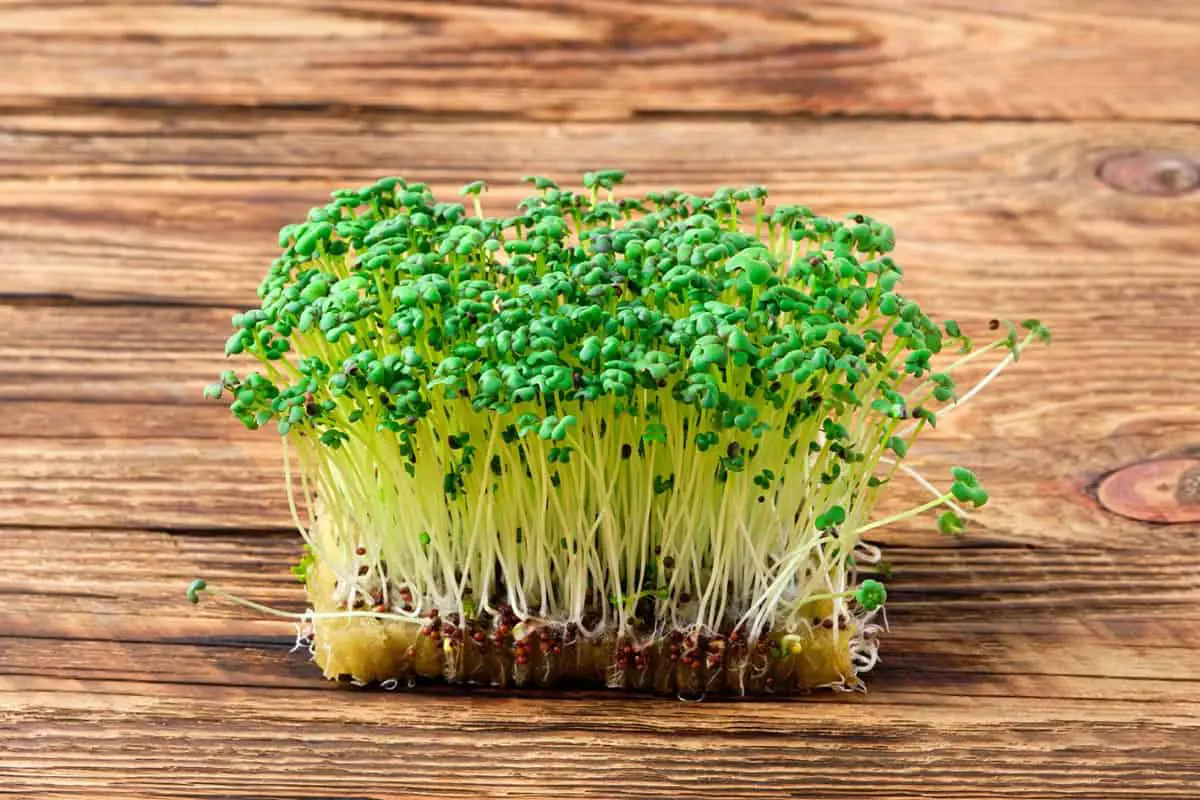
“Mustard greens are rich in important plant compounds and micronutrients, specifically vitamins A, C, and K. As a result, eating them may have benefits for eye and heart health, as well as anticancer and immune-boosting properties.”
Source: Mustard Greens – Nutrition Facts and Health Benefits
Mustard seeds take about 3 days to germinate and take another 5 to 8 days before being ready for harvesting. Mustard seeds do not require soaking and grow best in soil or a hydroponic medium.
Learn more about Mustard Microgreens.
Summary
Microgreens are jam-packed with nutrition and there is nothing but good coming out of growing them. Despite their small size, they often contain higher levels of nutrition than more mature vegetable greens. This makes them a healthy addition to any diet.
There are more than 100 types of microgreens and the choice of what to grow is so individual. By providing you this list of 14 of the most nutritious ones, we hope you are inspired to start growing your own.


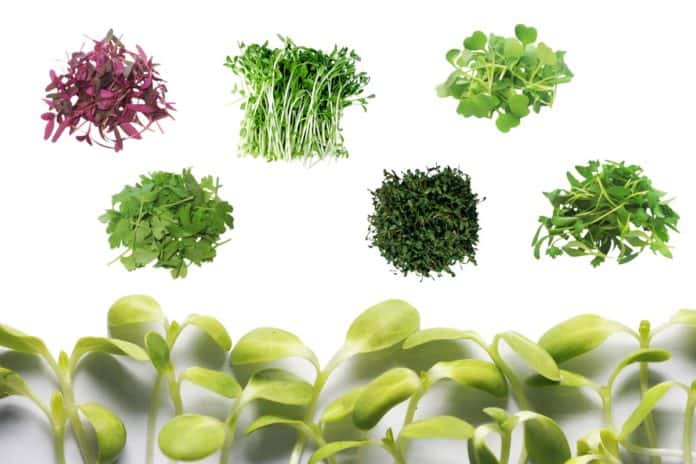
great read, very informative really apricate the information thankyou.
Glad you liked it!